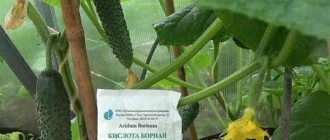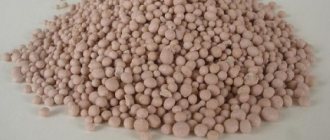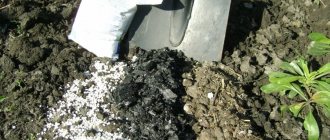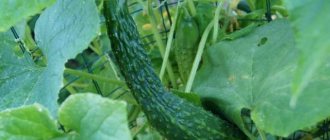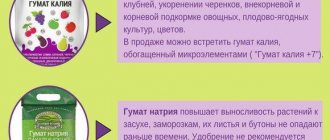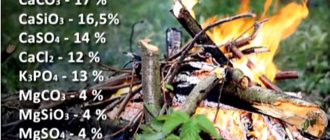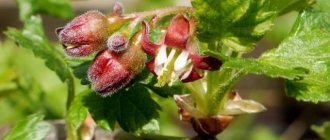Phosphorite flour - what is it?
This fertilizer is a mineral of natural origin. The main elements of powdered fertilizer are colored gray or brown, and it is easy to use. This composition is extracted from the soil, which contains sedimentary rocks consisting of more than 50 minerals.
To produce phosphate rock, an industrial method is used, which involves mining minerals from the apatite group in the mountains. Their peculiarity is that they were formed by organic bone deposits several hundred thousand years ago. The mined rock is cleaned and ground to a powdery state. The resulting fertilizer is natural and environmentally friendly.
Impact on grown crops
Phosphorus flour has a beneficial effect on almost all plants, but there are a number of crops that do not absorb phosphorus well.
Buckwheat, mustard and lupine
The cultivated crops themselves are a rich source of phosphorus for the soil, which is why they quickly take on beneficial properties from complementary foods. Growing these crops enriches the soil with essential microelements. After harvesting, the land is saturated with nitrogen and organic components.
See also
Instructions for using diammophos and fertilizer composition
Read
Hemp, peas and sweet clover, as well as sainfoin
The crops in question are also enriched with phosphorites, which is why their cultivation helps enrich the soil with micronutrients. The varieties absorb phosphorus well, and then process it into acids.
Cereals, potatoes, rice, vetch and beets
Such plants absorb phosphorus powder well only in acidic soil types. The difference is that the crops absorb small amounts of calcium (an element abundantly present in complementary foods).
Flax, barley, millet, tomato, spring wheat and turnip
These plant varieties do not take phosphorus well. For their fertility, it is necessary to use areas where the soil has average pH levels.
Composition and properties
Phosphorite flour consists of the following elements:
- phosphorus – 17%
- calcium – 30%;
- silicon – 18%;
- magnesium – 2%;
- complex of microelements.
Attention!
The composition of the fertilizer has the same proportions of microelements as the soil. Therefore, plants get everything they need from the soil.
The storage of phosphorites can be long-term, since they do not absorb moisture and do not cake. But they should be stored as far as possible from food.
Due to the fact that phosphate rock is similar in composition to the composition of soil, its saturation occurs without harm. The use of this fertilizer will help restore the acid-base balance of the soil. The structure of the fertilizer is fine-grained, so it will dissolve under the influence of weak acids. Therefore, phosphate rock is well absorbed by crops even in soil with high acidity. But before saturating it, you should thoroughly mix the fertilizer with the soil.
Properties of phosphorus flour:
- the formation of the root system improves;
- frost resistance increases;
- the number of bushes increases;
- culture growth accelerates;
- productivity increases.
Attention!
The use of phosphate rock undoubtedly has many advantages, but there is also a drawback - it can retain water in the beds.
When using this fertilizer, it is necessary to take into account that it has a long-lasting effect. Therefore, it should be applied approximately once every 5 years. Beginning of the form
Phosphorite flour - composition, properties, application technology
Phosphorite flour has the appearance of a crushed gray powder with an earthy color. It contains phosphorus - 17%, calcium -30%, magnesium - 2%, silica -18%. In addition, it contains a complex of microelements AL2O3, ZO2, F2O3, SO2, CuO. Moreover, microelements are contained in it in proportions corresponding to the standard level of their content in the soil.
In the production of flour, natural phosphorites are used, which are first enriched and then crushed. It is free-flowing, inert, non-hygroscopic, and can be stored for a long time without caking or losing its qualities.
Due to the fact that flour has the form of a fine powder, weak acids can dissolve it. Therefore, in acidic soils, a solution of phosphate rock can be absorbed by plants. The degree of digestibility is determined by how finely the flour is ground, how well it is mixed with the soil, and it also depends on the acidity of the soil and on some processes occurring inside the plants.
Phosphorite flour is used as a pre-sowing fertilizer on depleted chernozems and red soils to weaken their acidity. In addition, its use ensures optimization of the phosphorus balance in the soil, which in turn leads to improved absorption of potassium and nitrogen by plants. As a result, the protein content in grain, sugar and starch in root vegetables and tubers increases.
The digestibility of phosphate rock increases when mixed with nitrogenous fertilizers such as ammonium sulfate. It can also be increased by composting flour with oxidized peat or manure. Adding flour to compost speeds up composting, reduces nitrogen loss and increases phosphorus absorption. Phosphorite flour is added to compost in a ratio of 1.5 - 3 kg per ton of compost.
If you mix flour with ash or with lime fertilizers, then its solubility and, accordingly, digestibility decreases. Therefore, if there is a need to carry out liming, the phosphate rock should be embedded deeper into the soil before this, and only after that lime should be added. But it would be wiser to carry out liming a year after adding flour.
Although the addition of phosphate rock to a certain extent reduces the acidity of the soil, it, however, cannot compete with lime in this regard. The rates for adding flour are similar to the rates for adding superphosphate. Phosphorite flour differs favorably from superphosphate in that it has a prolonged effect and is more easily absorbed by the soil and is better retained by it. Therefore, it is applied no more than once every few years.
Phosphate rock is added before sowing plants. The method of application is that first the flour is scattered over the area, and then the entire area is dug up to incorporate the flour into the soil. Thus, no chemical reagents are used in the production of flour; it can be used for all crops. Flour consumption rate is 1.5 – 2 t/ha.
Phosphorite flour is a slightly toxic substance, so working with it requires precautions. Gloves, respirators or gauze dressings must be used. Upon completion of work, you should wash exposed areas of the body with soap. If flour gets into your eyes, rinse them with water and seek medical help.
If flour gets into your respiratory system, you should immediately go out into fresh air. After which you should rinse your mouth with water and drink about a liter of water with activated carbon.
Places for storing phosphate rock should be chosen so that it does not come into contact with food and feed. The room must be dry and closed.
We recommend reading:
Urea (urea), composition, properties, application technology Basic methods of growing plants hydroponically Why tomatoes are useful How to grow remontant strawberries from seeds Application of liquid mineral fertilizers using fertilizer spreaders Phosphorite flour - composition, properties, application technology Complexes of microelements - new generation fertilizers Watering plot: basic rules Astilbe is a beautiful decoration in your blooming garden. Features of cultivation. We stimulate the development of embryos with the help of cooling - we increase the hatchability of eggs Technology for cultivating potatoes on your own plot Graceful clematis Why Jerusalem artichoke is useful The role of potassium in ensuring the normal functioning of plants Insecticides - a means of protecting plants from harmful insects
Signs of phosphorus deficiency
A lack of phosphorus is easy to notice. The leaves on the crop grow small, the veins become purple. And the branches on the trees become brittle.
During the formation of ovaries, a deficiency of this element is expressed in slow growth and shedding of the flower. Often, harmful changes in the development of a plant begin with the lower leaves, and the upper ones simply curl. Next comes the turn of the shoots and eyes - they change their appearance.
Other symptoms of phosphorus deficiency are also known:
- leaves become dry and black;
- the flowering period is extended;
- crops mature later and grow more slowly;
- roots develop poorly.
Attention!
These signs of an essential element deficiency are more common, but other symptoms also exist.
If these signs are noticed, it is necessary to apply fertilizer.
Required amount of phosphorus
The use of phosphorus flour will help prevent a lack of micronutrients in fruit and berry crops. It is necessary to add phosphorites because:
- the roots begin to develop better. Otherwise, the plant will not be able to absorb nitrogen;
- metabolism is normalized. This process depends on a developed root system, and if it is poorly formed, then the nutrition of the crop and the appearance of fruits in the future are in question;
- due to poor nitrogen absorption, photosynthesis is disrupted and chlorophyll is not formed. Therefore, the leaves change their color from green to blue or purple;
- the taste of the fruit changes. Lack of potassium makes them sour;
- growth of new shoots is needed.
Negative changes are noticeable immediately, so gardeners quickly take the necessary measures to eliminate them.
Fertilizer using grass
This feeding is one of the simplest and most effective. You can prepare it in the following ways:
- water and grass;
- liquid, grass and nitrogen fertilizers.
Food prepared using one of these methods is affordable and healthy. To add the necessary elements to several acres of land, 200 liters of the resulting solution is enough.
Preparation:
- collect the grass and grind it thoroughly to quickly prepare fertilizer. Mostly gardeners and gardeners use weeds or tops from the harvested crop;
- Divide the resulting mixture into containers, compact it and fill it with water in a ratio of 1 to 1. The liquid must be warm or hot;
- To speed up fermentation, substances that are sources of nitrogenous compounds can be added to the mixture. They promote the rapid proliferation of bacteria, and the fertilizer is effective.
Attention!
You need to use waterproof containers: buckets, barrels and plastic canisters, etc.
Mix the finished mixture and squeeze out the cake, which can be used together with liquid. Experts advise using cake for mulching. It is also suitable for lining fruit trees.
How to use as fertilizer
If it is necessary to saturate the soil with microelements and useful components, you need to add a dry mixture. For complementary feeding, dilute the powder in water, and then spray the plants with the resulting solution.
The dose of complementary feeding should be calculated based on the composition of the soil:
- light mechanical – 0.9 t/ha;
- heavy – 2.3 t/ha.
In the case when the powder needs to be used as an additional fertilizer, it is necessary to prepare a solution: dissolve 20 g of the substance in 10 liters of water.
Fertilizer has a long-lasting effect, so it should be applied no more than once every 5 years. If it is necessary to feed a crop with short roots, then phosphate rock must be poured over almost the entire surface. In the case of a deep root system, the powder must be poured into the bottom of the prepared depression.
Attention!
To obtain a more effective result, you need to use the fertilizer on acidic soil or mix it with acid (peat, etc.). But you can’t mix it with ash, slaked lime, or chalk.
If the content of phosphoric acid in the soil is exceeded, the plants are not in danger.
Positive Features
The main advantage of using flour is its shelf life. The fertilizer can be used once every 4-5 years without loss of effectiveness.
The substances are resistant to moisture, so they will not be frightened by rain or watering. They do not sink into the lower layers of the soil. Knowing this feature, it is worthwhile to assume in advance what crops will be grown on the site. If you plan to grow crops with deep roots, you should apply fertilizer deeper.
An excellent effect is obtained by maintaining a proportion of 100-300 grams of finished fertilizer per square meter.
Additionally, phosphorus flour can be used when composting manure. Proportion: 15-20 kg of flour per 1 ton of manure.
To increase the digestibility of the drug, it can be mixed with ammonium sulfate, oxidized peat and manure.
It is important to know that flour has an excellent effect on the accumulation of humus in the soil and improves its composition. Thanks to this, the soil can be further enriched and the chances of obtaining a better harvest can be increased.
Precautionary measures
Phosphorite flour is a low-toxic substance. But you still need to adhere to safety rules. First of all, when working with fertilizer, use personal protective equipment: gloves, goggles, respiratory mask. Secondly, exposed skin also needs protection.
After finishing work with feeding, wash all clothes, and wash your hands and exposed skin with soap. If flour gets into your eyes, rinse them with plenty of water, then seek medical help.
If it gets into the respiratory tract, you should immediately go out into the open air and rinse your mouth with clean water. To prevent intoxication, you should drink a solution of 1 liter of water and activated carbon.
Attention!
The drug should be stored out of the reach of children and animals.
Before using phosphate rock, you must pay attention to the expiration date and the temperature at which it was stored.
Security measures
Phosphorite flour is considered a fairly environmentally friendly fertilizer. However, it still contains toxins. Therefore, soil cultivation must be carried out strictly in work clothes, gloves, goggles and a protective gauze bandage. After the soil and plants have been treated, clothes must be cleaned of fertilizer residues, and hands and face must be washed with soap.
The difference between flour and superphosphates
When comparing superphosphates with phosphorus flour, you will notice that the former have a more acidic reaction. Therefore, it is incorrect to draw a parallel between these two types of fertilizer. Each of them can be used for certain types of soil. It is better to feed alkaline or neutral soil with superphosphate. It contains a lot of sulfur, so it is useful for plants that are deficient in this element.
The benefits of phosphate rock are more noticeable on acidic soil. It is often used to restore fields after applying mineral fertilizers and increasing acidity.
Sometimes farmers use superphosphates and phosphate rock at the same time. This approach is advisable when it is necessary to quickly dissolve phosphorites and fertilizers begin to complement each other.
Fertilizer substitutes
Instead of phosphorus flour, the use of mineral fertilizers is allowed:
- precipitate - contains phosphorus in an amount of 27-28%. Used as the main fertilizer before planting crops. You should refrain from feeding plants during growth and vegetation;
- phosphate slag – phosphorus content at 6-20%. Use as precipitate;
- superphosphate – 14-20% phosphorus. Used more often than others. Cannot be combined with other fertilizers. Suitable for use on any soil, but on acidic soil it can be applied only after neutralization.
Attention!
You need to select fertilizer taking into account the needs of the soil and its type.
Alternative replacement for phosphate rock
Plants can be grown on acidic soils without using phosphate rock. To do this, it will be enough to use mineral fertilizers that contain phosphorus. Such substances include:
- phosphate slag - phosphorus content 6–20%;
- precipitate - phosphorus content 27–48%.
These fertilizers are used only as pre-planting base material. As supplements, they are of no value.
As you can see, phosphorus flour is an indispensable assistant for every gardener. Using this fertilizer, you can restore the quality of the soil and significantly increase crop yields. However, do not forget about the rules and dosages of application. Large amounts of fertilizer can have a negative effect on plants.
Reviews
Inna, Krasnoyarsk
For a long time I could not collect a rich harvest of fruit. I used various fertilizers for the garden, both store-bought and prepared according to folk recipes. But I had to look for more effective ways, since the food was not lost from the entire harvest. Everything changed after applying grass fertilizer. Now the harvest makes me happy, and the trees are not in danger.
Oleg, Naberezhnye Chelny
In the region where I live, the soil is highly acidic. Therefore, an effective fertilizer in this case is phosphate rock. There is nothing complicated in processing, so I do everything myself. It is better to perform the procedure early in the morning. In addition, I often use grass fertilizers. Such fertilizing is not only profitable and effective, but also helps clear the area of excess vegetation.
Application
The application of phosphate rock is carried out during deep plowing/digging of the soil, in autumn or spring. The powder is evenly scattered over the surface of the earth and plowed/digged. The fertilizer should immediately fall into a well-moistened layer of soil and remain there. If local conditions require liming with lime or dolomite flour (on drained peat bogs and swamps, see above), it is carried out after incorporating phosphate rock into the soil. Application rates and application deadlines:
- Phosphoritization (filling with phosphorus and deoxidizing newly developed lands) – 180-200 g/area or 1 tbsp. l. per 1 sq. m. Once at the beginning of cultivation.
- Phosphorus filling – 120-150 g/area or 2 tsp. per 1 sq. m. The first is 7-8 years after phosphoritation of podzols and 5-6 years of strongly acidic soils. Subsequent ones – in 3-4 years.
- Compost fertilization - 1.25 kg per 1 cubic meter. m of vegetable or peat; 2.5 kg/cu.m. m of manure or from household waste. Phosphorite flour is added once when loading a compost pit or filling a heap. After adding, the contents of the pit/heap are mixed with a pitchfork.
In the south of the Russian Federation, where there is usually an excess of calcium and silica in the soil, it is advisable to apply phosphate rock to calcium- and silicon-loving crops, for example. grape. Application is carried out in the fall after harvesting, this will increase the yield and resistance of plants to diseases for the next year. It is undesirable to fill the vineyard soil with phosphate rock in the spring: the berries may turn out to be stringy, low in sugar, and tasteless.
Note: Phosphate rock can be added to southern neutral soils and greenhouse soils in mixtures with ammonium sulfate (NH4)2SO4. This acidic fertilizer will neutralize the alkalinity of the phosphorites and introduce slow-acting ammonium (ammonium) nitrogen into the soil.
In conclusion, see the video about the use of phosphorus fertilizers in private household plots and in the country:
Video: phosphorus and phosphorus fertilizers for fruits and vegetables
Video: phosphorus fertilizers for tomatoes
Video: phosphorus fertilizing of strawberries
For strawberries:
